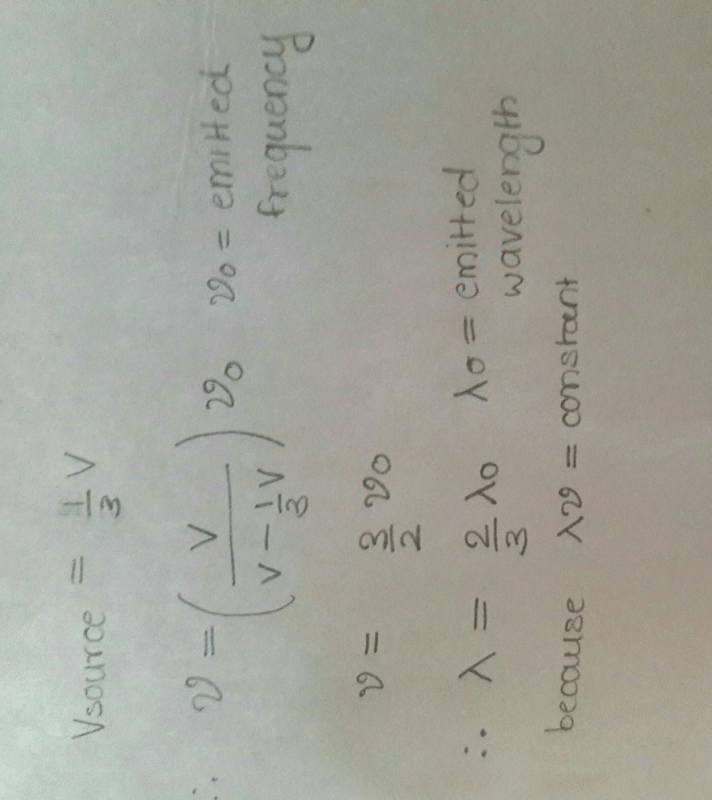Class 11 Exam > Class 11 Questions > If a source of sound was moving toward a rece...
Start Learning for Free
If a source of sound was moving toward a receiver at 1/3 the speed of sound, what would the resulting wavelength be?
- a)6 times the emitted wavelength
- b)2/3 of the emitted wavelength
- c)1/3 of the emitted wavelength
- d)Can not be found
Correct answer is option 'B'. Can you explain this answer?
Verified Answer
If a source of sound was moving toward a receiver at 1/3 the speed of ...
We need to find the resulting wavelength of the sound wave, which can be calculated using the formula: λ' = λ(v +/- vs) / (v + u) Since the source is moving towards the observer, we can use the negative sign for vs: λ' = λ(v - vs) / (v + u) λ' = λ(v - (-1/3)v) / (v + u) λ' = λ(4/3v) / (v + u) We can also use the formula for the speed of the sound wave: v = fλ which gives us: λ = v/f Substituting this value in the above equation, we get: λ' = (4/3)(v/f) / (v + u) λ' = (4/3)f / (3v + u) We know that the velocity of the observer (u) is zero since it is stationary. Thus, the equation simplifies to: λ' = (4/9)f/v This means that the resulting wavelength is 2/3 of the emitted wavelength since: λ' / λ = (4/9f/v) / (f/v) = 4/9 = 0.44 Therefore, the correct answer is option B, 2/3 of the emitted wavelength.
Most Upvoted Answer
If a source of sound was moving toward a receiver at 1/3 the speed of ...
Concept:
The Doppler Effect is the change in frequency or wavelength of a wave in relation to an observer who is moving relative to the wave source. When the source moves toward the observer, the frequency and wavelength are increased, while moving away from the observer decreases the frequency and wavelength.
Formula:
The formula for the Doppler Effect for sound waves is given by:
f' = f(v + u) / (v +/- vs)
where,
f' = frequency of the observed wave
f = frequency of the emitted wave
v = velocity of sound
u = velocity of the observer
vs = velocity of the source
Calculation:
Given, the source of sound is moving towards the receiver at 1/3 the speed of sound. This means that the velocity of the source (vs) is (-1/3)v since it is moving towards the observer.
We need to find the resulting wavelength of the sound wave, which can be calculated using the formula:
λ' = λ(v +/- vs) / (v + u)
Since the source is moving towards the observer, we can use the negative sign for vs:
λ' = λ(v - vs) / (v + u)
λ' = λ(v - (-1/3)v) / (v + u)
λ' = λ(4/3v) / (v + u)
We can also use the formula for the speed of the sound wave:
v = fλ
which gives us:
λ = v/f
Substituting this value in the above equation, we get:
λ' = (4/3)(v/f) / (v + u)
λ' = (4/3)f / (3v + u)
We know that the velocity of the observer (u) is zero since it is stationary. Thus, the equation simplifies to:
λ' = (4/9)f/v
This means that the resulting wavelength is 2/3 of the emitted wavelength since:
λ' / λ = (4/9f/v) / (f/v) = 4/9 = 0.44
Therefore, the correct answer is option B, 2/3 of the emitted wavelength.
The Doppler Effect is the change in frequency or wavelength of a wave in relation to an observer who is moving relative to the wave source. When the source moves toward the observer, the frequency and wavelength are increased, while moving away from the observer decreases the frequency and wavelength.
Formula:
The formula for the Doppler Effect for sound waves is given by:
f' = f(v + u) / (v +/- vs)
where,
f' = frequency of the observed wave
f = frequency of the emitted wave
v = velocity of sound
u = velocity of the observer
vs = velocity of the source
Calculation:
Given, the source of sound is moving towards the receiver at 1/3 the speed of sound. This means that the velocity of the source (vs) is (-1/3)v since it is moving towards the observer.
We need to find the resulting wavelength of the sound wave, which can be calculated using the formula:
λ' = λ(v +/- vs) / (v + u)
Since the source is moving towards the observer, we can use the negative sign for vs:
λ' = λ(v - vs) / (v + u)
λ' = λ(v - (-1/3)v) / (v + u)
λ' = λ(4/3v) / (v + u)
We can also use the formula for the speed of the sound wave:
v = fλ
which gives us:
λ = v/f
Substituting this value in the above equation, we get:
λ' = (4/3)(v/f) / (v + u)
λ' = (4/3)f / (3v + u)
We know that the velocity of the observer (u) is zero since it is stationary. Thus, the equation simplifies to:
λ' = (4/9)f/v
This means that the resulting wavelength is 2/3 of the emitted wavelength since:
λ' / λ = (4/9f/v) / (f/v) = 4/9 = 0.44
Therefore, the correct answer is option B, 2/3 of the emitted wavelength.
Free Test
FREE
| Start Free Test |
Community Answer
If a source of sound was moving toward a receiver at 1/3 the speed of ...


|
Explore Courses for Class 11 exam
|

|
Question Description
If a source of sound was moving toward a receiver at 1/3 the speed of sound, what would the resulting wavelength be?a)6 times the emitted wavelengthb)2/3 of the emitted wavelengthc)1/3 of the emitted wavelengthd)Can not be foundCorrect answer is option 'B'. Can you explain this answer? for Class 11 2025 is part of Class 11 preparation. The Question and answers have been prepared according to the Class 11 exam syllabus. Information about If a source of sound was moving toward a receiver at 1/3 the speed of sound, what would the resulting wavelength be?a)6 times the emitted wavelengthb)2/3 of the emitted wavelengthc)1/3 of the emitted wavelengthd)Can not be foundCorrect answer is option 'B'. Can you explain this answer? covers all topics & solutions for Class 11 2025 Exam. Find important definitions, questions, meanings, examples, exercises and tests below for If a source of sound was moving toward a receiver at 1/3 the speed of sound, what would the resulting wavelength be?a)6 times the emitted wavelengthb)2/3 of the emitted wavelengthc)1/3 of the emitted wavelengthd)Can not be foundCorrect answer is option 'B'. Can you explain this answer?.
If a source of sound was moving toward a receiver at 1/3 the speed of sound, what would the resulting wavelength be?a)6 times the emitted wavelengthb)2/3 of the emitted wavelengthc)1/3 of the emitted wavelengthd)Can not be foundCorrect answer is option 'B'. Can you explain this answer? for Class 11 2025 is part of Class 11 preparation. The Question and answers have been prepared according to the Class 11 exam syllabus. Information about If a source of sound was moving toward a receiver at 1/3 the speed of sound, what would the resulting wavelength be?a)6 times the emitted wavelengthb)2/3 of the emitted wavelengthc)1/3 of the emitted wavelengthd)Can not be foundCorrect answer is option 'B'. Can you explain this answer? covers all topics & solutions for Class 11 2025 Exam. Find important definitions, questions, meanings, examples, exercises and tests below for If a source of sound was moving toward a receiver at 1/3 the speed of sound, what would the resulting wavelength be?a)6 times the emitted wavelengthb)2/3 of the emitted wavelengthc)1/3 of the emitted wavelengthd)Can not be foundCorrect answer is option 'B'. Can you explain this answer?.
Solutions for If a source of sound was moving toward a receiver at 1/3 the speed of sound, what would the resulting wavelength be?a)6 times the emitted wavelengthb)2/3 of the emitted wavelengthc)1/3 of the emitted wavelengthd)Can not be foundCorrect answer is option 'B'. Can you explain this answer? in English & in Hindi are available as part of our courses for Class 11.
Download more important topics, notes, lectures and mock test series for Class 11 Exam by signing up for free.
Here you can find the meaning of If a source of sound was moving toward a receiver at 1/3 the speed of sound, what would the resulting wavelength be?a)6 times the emitted wavelengthb)2/3 of the emitted wavelengthc)1/3 of the emitted wavelengthd)Can not be foundCorrect answer is option 'B'. Can you explain this answer? defined & explained in the simplest way possible. Besides giving the explanation of
If a source of sound was moving toward a receiver at 1/3 the speed of sound, what would the resulting wavelength be?a)6 times the emitted wavelengthb)2/3 of the emitted wavelengthc)1/3 of the emitted wavelengthd)Can not be foundCorrect answer is option 'B'. Can you explain this answer?, a detailed solution for If a source of sound was moving toward a receiver at 1/3 the speed of sound, what would the resulting wavelength be?a)6 times the emitted wavelengthb)2/3 of the emitted wavelengthc)1/3 of the emitted wavelengthd)Can not be foundCorrect answer is option 'B'. Can you explain this answer? has been provided alongside types of If a source of sound was moving toward a receiver at 1/3 the speed of sound, what would the resulting wavelength be?a)6 times the emitted wavelengthb)2/3 of the emitted wavelengthc)1/3 of the emitted wavelengthd)Can not be foundCorrect answer is option 'B'. Can you explain this answer? theory, EduRev gives you an
ample number of questions to practice If a source of sound was moving toward a receiver at 1/3 the speed of sound, what would the resulting wavelength be?a)6 times the emitted wavelengthb)2/3 of the emitted wavelengthc)1/3 of the emitted wavelengthd)Can not be foundCorrect answer is option 'B'. Can you explain this answer? tests, examples and also practice Class 11 tests.

|
Explore Courses for Class 11 exam
|

|
Signup for Free!
Signup to see your scores go up within 7 days! Learn & Practice with 1000+ FREE Notes, Videos & Tests.


















